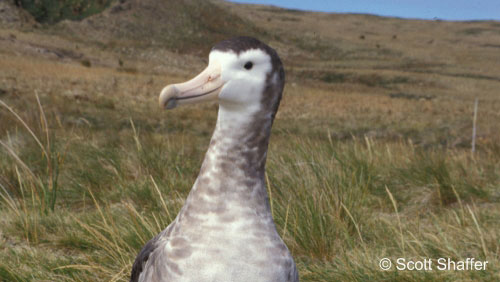Christophe Barbraud of the Centre d'Etudes Biologiques de Chizé, France and colleagues writing in the Journal of Animal Ecology have studied how Amsterdam Diomedea amsterdamensis and Black-browed Thalassarche melanophris Albatrosses and Snow Petrels Pagodroma nivea might react to climate change.
The paper's summary follows:
"1. Recent climate change has affected a wide range of species, but predicting population responses to projected climate change using population dynamics theory and models remains challenging, and very few attempts have been made. The Southern Ocean sea surface temperature and sea ice extent are projected to warm and shrink as concentrations of atmospheric greenhouse gases increase, and several top predator species are affected by fluctuations in these oceanographic variables.
2. We compared and projected the population responses of three seabird species living in subtropical, sub-Antarctic and Antarctic biomes to predicted climate change over the next 50 years. Using stochastic population models we combined long-term demographic datasets and projections of sea surface temperature and sea ice extent for three different IPCC emission scenarios (from most to least severe: A1B, A2, B1) from general circulation models of Earth's climate.
3. We found that climate mostly affected the probability to breed successfully, and in one case adult survival. Interestingly, frequent nonlinear relationships in demographic responses to climate were detected. Models forced by future predicted climatic change provided contrasted population responses depending on the species considered. The northernmost distributed species was predicted to be little affected by a future warming of the Southern Ocean, whereas steep declines were projected for the more southerly distributed species due to sea surface temperature warming and decrease in sea ice extent. For the most southerly distributed species, the A1B and B1 emission scenarios were respectively the most and less damaging. For the two other species, population responses were similar for all emission scenarios.
4. This is among the first attempts to study the demographic responses for several populations with contrasted environmental conditions, which illustrates that investigating the effects of climate change on core population dynamics is feasible for different populations using a common methodological framework. Our approach was limited to single populations and have neglected population settlement in new favourable habitats or changes in inter-specific relations as a potential response to future climate change. Predictions may be enhanced by merging demographic population models and climatic envelope models."

Reference:
Barbraud, C., Rivalan, P., Inchausti, P., Nevoux, N., Rolland, V. & Weimerskirch, H. 2011. Contrasted demographic responses facing future climate change in Southern Ocean seabirds. Journal of Animal Ecology 80: 89-100.
John Cooper, ACAP Information Officer, 9 January 2011

 English
English  Français
Français  Español
Español